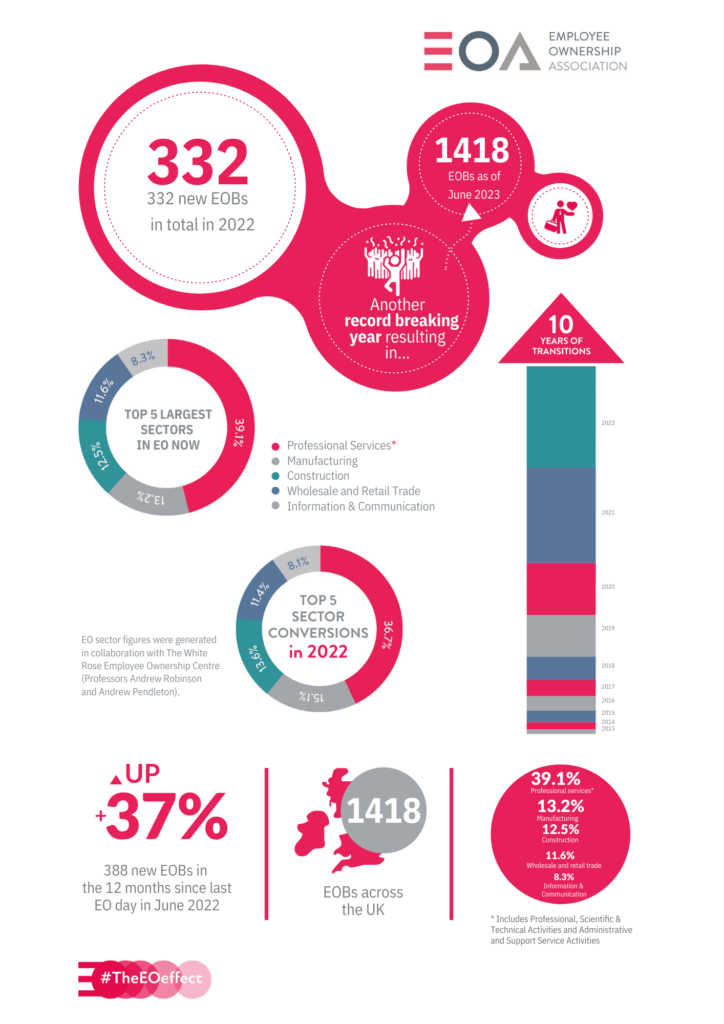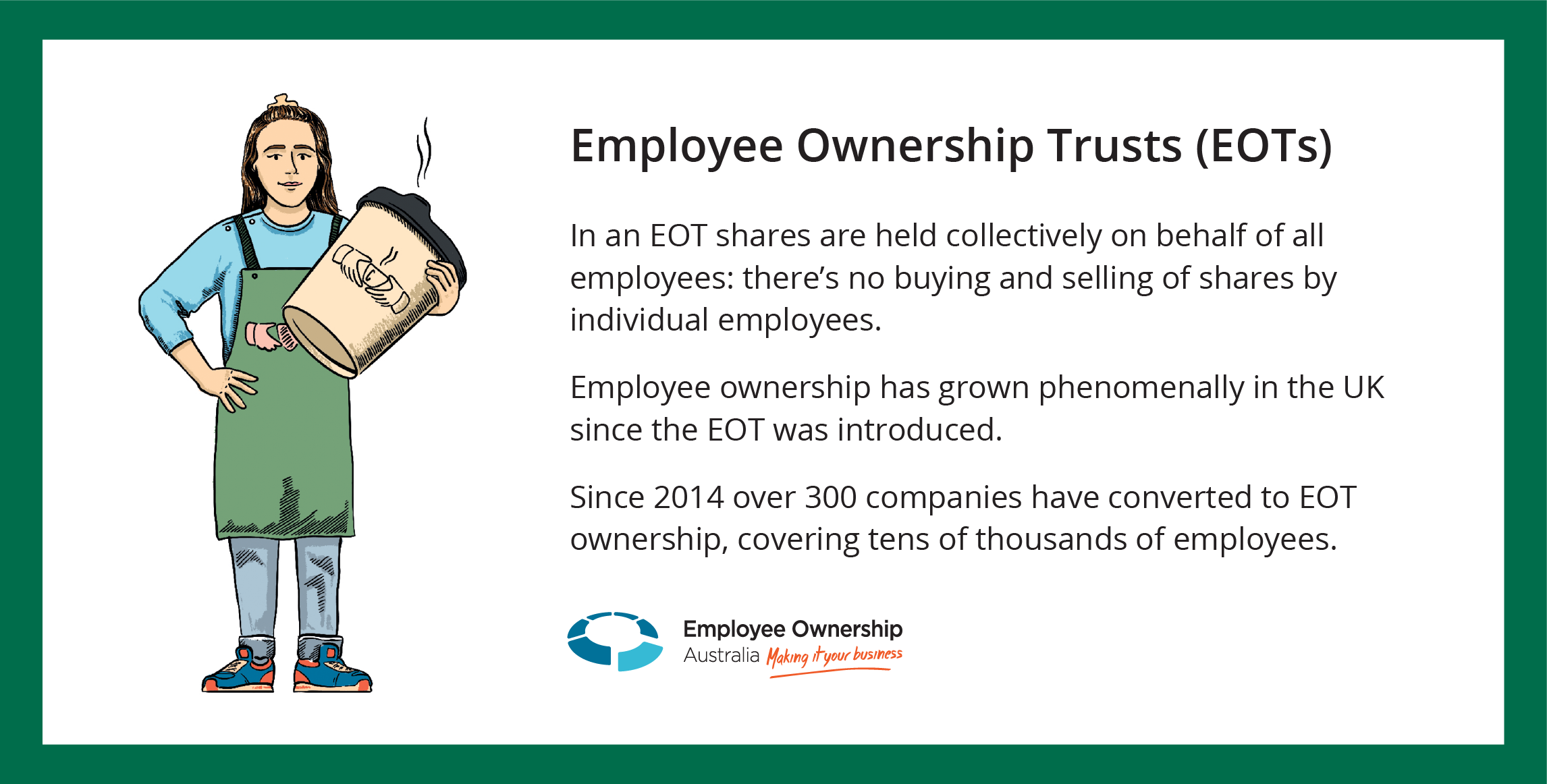Employee Ownership Trusts in Australia
An Employee Ownership Trust (EOT) is a special form of ‘trust to the benefit of employees’ introduced by the UK Government in September 2014 to encourage more business owners and shareholders to set up a corporate structure similar to the successful, well-known and long-standing international examples like Arup (in engineering) and the John Lewis Partnership (in retail see also “A Better Way of Doing Business”). The aim was to facilitate wider employee ownership and worker buyouts – albeit via an indirect holding – by offering ‘ease of access’ to the EOT structure.
In the few years since, the result has been a resurgence of interest in employee ownership, with a large number of small and medium-sized, privately owned business enterprises announcing moves to employee ownership via the EOT for reasons mostly related to business succession and preserving the ‘legacy’ for the founders. The model is most popular for ‘transitioning ownership’ in profitable, ‘staff rich’ businesses which have considerable assets. The model is not as useful in ‘business rescue’ cases where viability is problematic and success uncertain.
The key advantage of the EOT model is that the operating entity remains the same, the EOT simply becomes the sole (or major) shareholder in the business. This also avoids the disadvantage of having to wind up the operating entity to enter a new form, such as a cooperative. As well, with the EOT business ‘self-financing’ the purchasing arrangement, this means that all employees can be included in the employee ownership structure as “one of our core principles is that no capital is required from staff (which would have the effect of excluding some people from it); another is that everyone will participate” (Steve Barty, Meld Studios, an EOT in Sydney). Employees can come and go without the need for ownership to change hands, although staff turnover tends to be much lower in employee-owned businesses anyway.
Employee Ownership Australia is now introducing the EOT model to Australia.
EOT’s are trusts established by a company to hold equity on behalf of its employees, with usually all – or at least a majority – of the shares being held by the trust. As well as structures where 100% of the shares are held by the trust, there can also be hybrid EO models, where a large percentage of the company’s equity is held by the trust, but with the rest belonging directly to employees, or to the company’s founders. It is important to remember that the EOT acts as a shareholder and not as a substitute for the company board.
The concept of the EOT was the result of recommendations put forward by Graeme Nuttall in his 2012 report “Sharing Success: The Nuttall Review of Employee Ownership” to the UK Government. Since then, the numbers have grown significantly with over 1400 now operating in the UK in mid-2023, (see diagram below), covering tens of thousands of employees. Others have commenced in the USA where EOTs of considerable scale are now taking off, such as precision optics manufacturer, Optimax, with 500 employees (see: ‘Optimax: an employee ownership trust’) and others are starting up in Canada and now Australia.
Research shows that the EOT appeals to the values of a millennial workforce and that employee-owned businesses are deemed to be more trustworthy. The benefits to employees are mostly found in the altered culture of an employee-owned business where long-term thinking, transparency, and collaborative behaviours tend to result in higher levels of innovation, employee well-being, and greater job satisfaction; all-important following the pandemic.
To implement an EOT in Australia, business owners will need to seek the assistance of qualified business advisors – lawyers and accountants – for setting up the trust structure correctly. Since every business is unique, advisers will conduct a thorough review of a company and its circumstances, while taking into account what its owners and employees want to achieve in the medium-to-long term. The advice required will include not only legal, finance and tax, but those key ‘people issues’ like workplace culture and staff engagement.
It is important also to distinguish EOT’s (Employee Ownership Trusts) from ESOP’s (Employee Share Ownership Plans) as the latter – while also be based on a ‘trust’ structure – actually allocates shares to employees via the trust, whereas in the EOT, all the shares allocated to it remain ‘collectively held’ within it.
See more details on this below.
What are the benefits of EOT’s?
- The EOT serves to ensure the company’s permanent commitment to its mission
- The EOT benefits its employees by creating high-quality jobs and through sharing in the economic and social gains that it makes.
- EOT’s create a mandate for employees to participate in its governance.
- EOT’s embed the benefits of employee voice and wealth building.
- Most EOT’s specify the process by which annual profits are distributed to employees.
- Employees can receive an annual cash benefit in an EOT – they do not have to wait until they depart from the company or when it is sold, as is the case with an ESOP – and those benefits can start flowing immediately if the company has the available cash flow.
- EOT’s claim that it is cheaper and simpler to administer – and that it provides more operating flexibility – than either an ESOP or a worker cooperative.
- In its simplest form, the EOT structure can serve smaller-sized companies that want to avoid the ongoing costs of an ESOP transaction, though the model can also fit much larger entities.
- In addition, EOTs don’t have the same need for ongoing cash flow and capital planning that ESOPs require to meet their share repurchasing obligations, since shares are allocated to the trust and not to individual employee accounts.
- EOTs can have the option to provide benefits to other stakeholders (e.g. suppliers or contractors) in addition to full-time employees, and to list additional purposes in their trust documents.
- EOTs contribute to maintaining control of the company against a potential takeover and may therefore act against increased corporate consolidation and the associated negative effect on worker wages and community wealth.
- The EOT ‘asset lock’ therefore ensures that the company will be operated by and for the employees in perpetuity.
RESOURCES
PEOPLE POWERED GROWTH 2023 – The rapid and impactful rise of employee and worker ownership in the UK | October 2023
Check out our “What it is like to work for an employee-owned business” (May, 2023).
A Practical Guide to Employee Ownership In Australia | KWM and Fieldfisher, November 2022.
Employee ownership trusts: a flexible solution to business succession (Webinar, Prof. Andrew Pendleton, University of NSW, June, 2022)
For more on the EOT in Australia, see: Solving succession woes with Employee Ownership Trusts (University of New South Wales, November 2021).
For more on the EOT in Australia, see EOA’s interview with Graeme Nuttall – our chief adviser on the project – in our blog Employee Ownership Trusts – A Refreshingly Different Ownership Model For Private Companies.
The Purpose of EOT’s, Graeme Nuttall, webinar for EO Australia, April 2022.
For a diagram of the EOT in a typical 100% employee trust-owned company, you can see it here.
The latest evidence from the UK on the number of employee-owned businesses (almost all EOTs):

If you wish further information on Employee Ownership Trusts in Australia, please contact us at info@employeeownership.com.au.
Additional information on the progress of EOTs in Australia – including examples – will be provided over the coming months.
For more on successful transitions of companies to employee ownership, see:
Webinar “Sharing Meld – Becoming Employee Owned by Trust” (17 August 2021 – 1 hour)
Meld Studios: Australia’s first company to become Employee-Owned by Trust (July 2021)
Women lead employee-owned businesses lead the way in Scotland
When staff run the show: the true benefits of employee ownership
See also our Employee Ownership Education page.
See also our “Business Successions” page and our Worker Buyouts page

